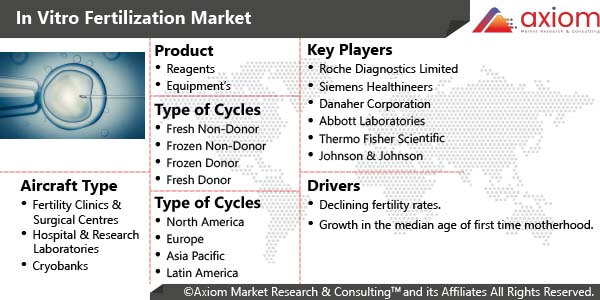In-vitro fertilization is a process of fertilization, used to treat fertility or genetic problems and assist with conception of child. In this process, an egg is combined with the sperm and fertilized in a lab. It is the most effective form of assisted reproductive technology. The success rate of the procedure depends on numerous factors including maternal age, cause of infertility, embryo status, reproductive history and lifestyle factors. IVF success rates have been increasing since its conception, owing to increasing research and technological advances. Presently, numerous research institutes and medical centers are capitalizing in R&D activities to improve the procedural efficiency and fertilization results. Besides, various government initiatives to lower the treatment cost are being undertaken to increase the adoption rate of IVF services.
In Vitro Fertilization Market Dynamics
The global In-vitro fertilization market is primarily driven by increasing incidences of infertility among male and female across the globe, decreasing fertility rate, rising male infertility, rise in consumption of alcohol and cigarettes, increasing awareness about in-vitro fertilization process and technologies. Growing prevalence of infertility will substantially impact in-vitro fertilization market growth in coming years. As indicated by, National Center for Biotechnology Information, approximately 8-12% of couples face issues such as infertility and impaired fecundity. Various factors including changing lifestyles, late childbearing, and heredity are the major risk factors that lead to infertility. Therefore, increasing risk factors coupled with growing acceptance of IVF procedures will lead in vitro fertilization market expansion over the forecast period.
Additionally, increasing government initiatives and flexible government regulation to promote IVF treatments are backing the grow of In-Vitro fertilization market. However, factors hindering the growth of in-vitro fertilization market growth includes excessive cost associated with the treatment and change in government regulation with respect to various countries.
In Vitro Fertilization Market Segmental Overview
The report analyses the global in-vitro fertilization market based on product, type of cycle, end user and geography. Various reagents and equipment’s are used in in vitro fertilization process.
In Vitro Fertilization Market By Product
Various reagents and equipment’s are used in in vitro fertilization process. The reagents segment consists of embryo culture media, cryopreservation media, sperm processing media and ovum processing media. Moreover, equipment segment include imaging system, sperm separation system, cabinet, ovum aspiration pump, Incubators, micro manipulation system, gas analyser, laser system, accessories, cryosystems, anti-vibration tables and witness system. Embryo culture media dominated the IVF reagents market and is also projected to grow at the highest pace during the forecast period. The large share of this segment is attributed to rising awareness of infertility treatment and diagnosis globally.
In Vitro Fertilization Market by Type of Cycles
Based on the cycle type, the global in-vitro fertilization market is segmented into fresh donor IVF cycle, fresh non-donor IVF cycle, frozen donor IVF Cycle and frozen non-donor IVF cycle. The fresh non-donor segment is expected to account for the largest share in the global in-vitro fertilization market during the forecast period, owing to the fact that it is the most common and easy method in an in-vitro fertilization process.
In Vitro Fertilization Market by End User
Based on end user, the in-vitro fertilization market is categorized into fertility clinics and surgical centres, hospital and research laboratories and cryobanks. The hospitals segment accounted for the largest share of the IVD market. The largest share of the market is attributed to full range of services provided in the hospitals including various diagnostics test and surging number of private hospitals.
In Vitro Fertilization Market by Geography
By geography, the global in-vitro fertilization market is studied across the countries of key regions such as, North America, Europe, Asia Pacific, Latin America, and Middle East & Africa. North America comprises United States, Canada and Mexico whereas Europe would primarily cover Germany, France, UK, Italy and Rest of Europe. The key countries included under Asia Pacific are China, Japan, India, Australia, and Rest of Asia Pacific. In Latin America, Brazil, Argentina, and Rest of Latin America are the key countries whereas in Middle East & Africa, South Africa and Rest of MEA are the key countries covered in the report. Asia-Pacific is anticipated to witness high growth during the forecast period, owing to the improved surrogacy laws, increasing healthcare expenditure, growing infertility rate due to changing lifestyle, less stringent regulatory environment, associated with in vitro fertilization. The low cost of IVF in Asia-Pacific, especially in India, when compared to developed countries, and the growing medical tourism for IVF are also supplementing the growth of the market in the region.,
In Vitro Fertilization Market Key Players
Some of the key participants of the global in-vitro fertilization market are Roche Diagnostics Limited (Switzerland), Siemens Healthineers (Germany), Danaher Corporation (US), Abbott Laboratories (US), and Thermo Fisher Scientific (US), Johnson & Johnson (US), Becton, Dickinson and Company (US), Bio-Rad Laboratories (US), Sysmex Corporation (Japan), bioMérieux (France), DiaSorin (Italy), Ortho Clinical Diagnostics (US), and QIAGEN (Germany) The in-vitro fertilization market players are adopting various strategies including technological advancement in terms of cost-effectiveness and portability, research & development, mergers and agreements to reinforce their position in the global market.











